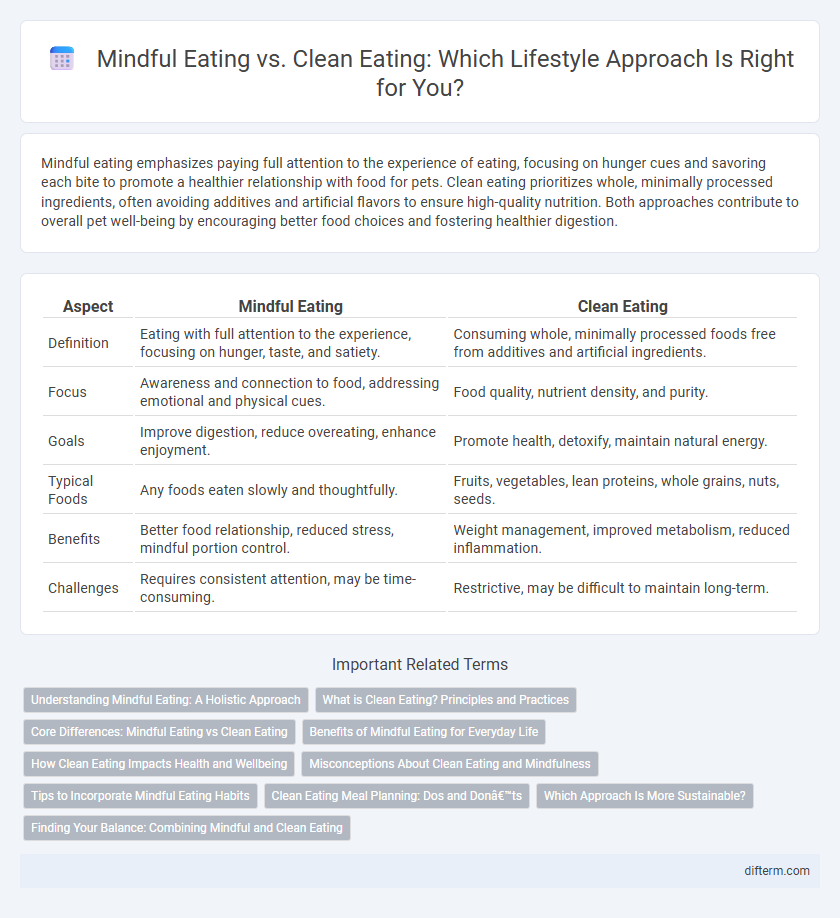Mindful eating emphasizes paying full attention to the experience of eating, focusing on hunger cues and savoring each bite to promote a healthier relationship with food for pets. Clean eating prioritizes whole, minimally processed ingredients, often avoiding additives and artificial flavors to ensure high-quality nutrition. Both approaches contribute to overall pet well-being by encouraging better food choices and fostering healthier digestion.
Table of Comparison
| Aspect | Mindful Eating | Clean Eating |
|---|---|---|
| Definition | Eating with full attention to the experience, focusing on hunger, taste, and satiety. | Consuming whole, minimally processed foods free from additives and artificial ingredients. |
| Focus | Awareness and connection to food, addressing emotional and physical cues. | Food quality, nutrient density, and purity. |
| Goals | Improve digestion, reduce overeating, enhance enjoyment. | Promote health, detoxify, maintain natural energy. |
| Typical Foods | Any foods eaten slowly and thoughtfully. | Fruits, vegetables, lean proteins, whole grains, nuts, seeds. |
| Benefits | Better food relationship, reduced stress, mindful portion control. | Weight management, improved metabolism, reduced inflammation. |
| Challenges | Requires consistent attention, may be time-consuming. | Restrictive, may be difficult to maintain long-term. |
Understanding Mindful Eating: A Holistic Approach
Mindful eating emphasizes a holistic approach by fostering awareness of hunger cues, emotional triggers, and the sensory experience of food, promoting a balanced relationship with eating habits. Unlike clean eating, which often focuses strictly on food quality and nutrient content, mindful eating encourages attentiveness to the present moment and internal signals, enhancing digestion and satisfaction. This practice supports mental wellness and sustainable lifestyle changes by integrating mindfulness techniques into daily nutrition choices.
What is Clean Eating? Principles and Practices
Clean eating emphasizes consuming whole, minimally processed foods that are as close to their natural state as possible, including fresh fruits, vegetables, whole grains, lean proteins, and healthy fats. Key principles involve avoiding refined sugars, artificial additives, and highly processed ingredients while prioritizing nutrient-dense, organic, and locally sourced options. Practices include meal prepping with simple recipes, reading ingredient labels carefully, and choosing seasonal produce to enhance nutritional quality and support sustainable food habits.
Core Differences: Mindful Eating vs Clean Eating
Mindful eating emphasizes awareness of hunger cues, eating sensations, and emotional triggers to foster a balanced relationship with food. Clean eating focuses on consuming whole, minimally processed foods, prioritizing nutritional quality and ingredient transparency. The core difference lies in mindful eating's attention to psychological and sensory experiences, whereas clean eating centers on food composition and purity.
Benefits of Mindful Eating for Everyday Life
Mindful eating cultivates awareness of hunger and fullness cues, promoting better digestion and reducing overeating. It enhances the enjoyment of food by encouraging focus on flavors and textures, leading to healthier food choices and improved emotional well-being. Practicing mindful eating consistently can support weight management and foster a balanced relationship with food in everyday life.
How Clean Eating Impacts Health and Wellbeing
Clean eating emphasizes consuming whole, minimally processed foods that retain their natural nutrients, promoting better digestion, sustained energy levels, and enhanced immune function. This dietary approach reduces exposure to artificial additives and preservatives, lowering inflammation and risk of chronic diseases such as diabetes and heart disease. Adopting clean eating habits supports mental clarity and emotional balance by stabilizing blood sugar and providing essential vitamins and minerals crucial for brain health.
Misconceptions About Clean Eating and Mindfulness
Clean eating is often misunderstood as strictly avoiding all processed foods, but it actually emphasizes balanced, nutrient-dense choices without extreme restrictions. Mindful eating focuses on present-moment awareness and the sensory experience of eating rather than specific food categories or purity. Both approaches promote healthier relationships with food, but clean eating misconceptions can drive unnecessary guilt, while mindfulness encourages a flexible, compassionate mindset.
Tips to Incorporate Mindful Eating Habits
Incorporate mindful eating habits by focusing on the quality and source of your food, chewing slowly to savor each bite, and paying full attention to hunger and fullness cues. Use smaller plates to help control portion sizes and eliminate distractions like screens during meals to engage more deeply with your food. Practicing regular mindfulness exercises can enhance your awareness of eating patterns and promote healthier, more intentional choices.
Clean Eating Meal Planning: Dos and Don’ts
Clean eating meal planning emphasizes whole, unprocessed foods, prioritizing fresh fruits, vegetables, lean proteins, and whole grains while avoiding artificial additives, refined sugars, and processed ingredients. Do focus on seasonal, nutrient-dense produce and prepare meals from scratch to maximize nutrient retention and flavor. Don't rely on packaged "clean" products with hidden preservatives or neglect hydration and balanced macronutrients essential for sustained energy and overall health.
Which Approach Is More Sustainable?
Mindful eating emphasizes awareness of hunger cues and emotional triggers, promoting a balanced relationship with food that can be maintained long-term, while clean eating focuses on consuming whole, unprocessed foods, potentially leading to stricter dietary rules. Studies suggest mindful eating fosters sustainable habits by reducing binge eating and improving psychological well-being, whereas clean eating's rigidity may result in diet fatigue or nutritional imbalances. Integrating mindful eating principles with clean eating's emphasis on quality ingredients may offer the most sustainable approach for lasting health benefits.
Finding Your Balance: Combining Mindful and Clean Eating
Finding your balance between mindful eating and clean eating involves integrating awareness with nutritional quality to enhance overall well-being. Mindful eating emphasizes presence and savoring each bite, reducing overeating and improving digestion, while clean eating focuses on consuming whole, unprocessed foods rich in vitamins and minerals. Combining these approaches fosters a sustainable lifestyle by promoting nutrient-dense meals enjoyed with intentionality, supporting both physical health and mental clarity.
Mindful Eating vs Clean Eating Infographic

 difterm.com
difterm.com